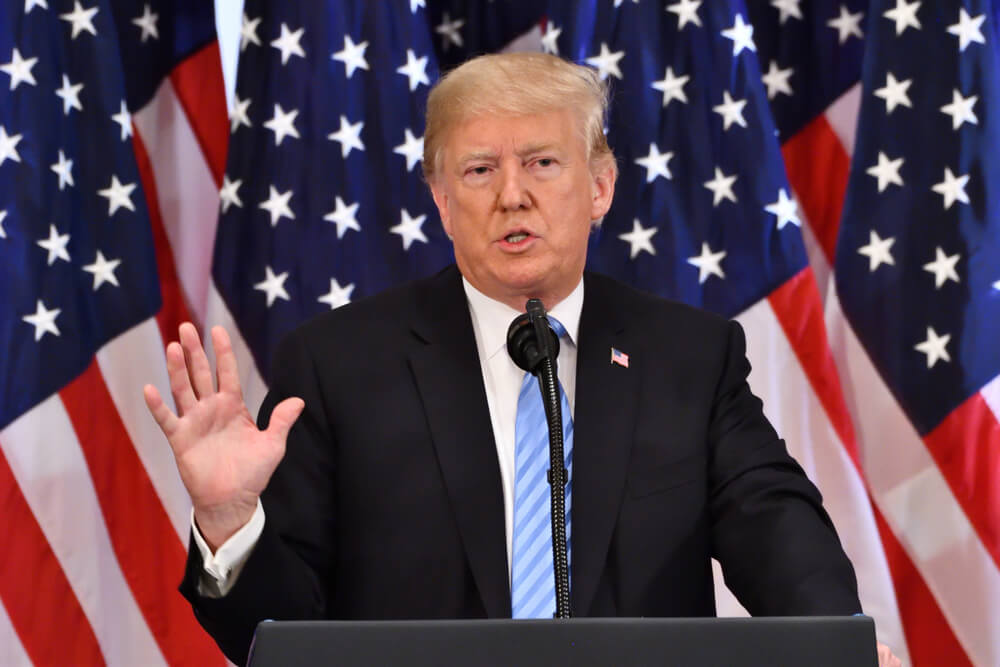President Donald Trump late Thursday evening said in a tweet that his administration is hitting Mexico with new tariffs over migrants traveling through the country and entering the United States illegally.
Tariffs have become the White House’s preferred method of doing business, and the new duties are aside from the new trade deal, the USMCA, the president struck with Mexico and Canada as a replacement for NAFTA.
The new tariffs will take effect on June 10, and Trump warned that the new levies will gradually increase to as high as 25% by Oct. 1, Trump said in a statement released by the White House.
“On June 10th, the United States will impose a 5% Tariff on all goods coming into our Country from Mexico, until such time as illegal migrants coming through Mexico, and into our Country, STOP,” Trump said via Twitter. “The Tariff will gradually increase until the Illegal Immigration problem is remedied, at which time the Tariffs will be removed. Details from the White House to follow.”
The new tariffs would have major implications for the U.S. auto industry and all companies who do business south of the border as Trump continues to ramp up trade wars across the globe, the latest news coming just days after his administration removed tariffs on steel coming from Mexico.
The move will come at a cost to both countries. The U.S. accounts for about four-fifths of all of Mexico’s exports, and about 28% of its total GDP, according to Bloomberg.
To the U.S., 5% tariffs on $346 billion worth of goods amounts to about $17 billion, rising to $87 billion if the tariffs hit 25%. U.S. consumers will end up footing the bill and the impact will be felt more directly than say with the tariffs against China, considering the amount of food that comes into the United States from Mexico.
Wall Street did not react well on the news, with the S&P 500 and Dow Jones Industrial both sinking 1.1% in pre-market trading Friday morning, and the Nasdaq down 1.3%. The news also sent the Mexican peso down 3%.
Mexican President Andres Manuel Lopez Obrador posted a letter on Twitter, saying “President Donald Trump in peace” in a tweet accompanying the letter, which is in Spanish.
The letter tells Trump that “social problems are not solved with duties or coercive measures” and alluded to the United States’ history as a nation of immigrants.
“The Statue of Liberty is not an empty symbol,” he wrote. He also said he was dispatching his foreign relations secretary to Washington on Friday to try to negotiate a solution, according to the Associated Press.
The timing is particularly peculiar, with the administration pushing hard to get the new USMCA trade pact finalized in Congress.
“The tariffs certainly put the USMCA on ice,” said Gary Hufbauer, an expert in trade law at the Peterson Institute for International Economics, who panned the move but said Trump does have the legal authority to impose the tariffs under the International Emergency Economic Powers Act by citing a national emergency.
“The drama is legal, but it’s preposterous,” he said.
Daniel Ujczo, a U.S.-based international trade lawyer, said the threat would likely slow the deal’s progress in Mexico and put U.S. lawmakers who want to vote “yes” in a difficult position because companies in their districts — and then ultimately U.S. consumers — will end up paying the tariffs.
Still, Ujczo and others wondered whether Trump would go through with the threat.
“This seems more theater and tactics than a strategy to solve the migration crisis and rebalance North American trade,” Ujczo said.
It wouldn’t be the first time Trump has backed off an immigration threat if that ends up being the case. Trump previously threatened to shut down the entire southern border if Mexico didn’t halt the migrants moving toward the U.S. border. A couple of days later he backed off, saying he was pleased Mexico was taking steps toward stopping the flow of migrants.
Update
Later in the morning, Trump tweeted again on the issue, putting the onus on Democrats because “they want Open Borders.”
Hard to believe that with the Crisis on the Border, the Dems won’t do the quick and easy fix. Would solve the problem but they want Open Borders, which equals crime!
— Donald J. Trump (@realDonaldTrump) May 31, 2019
Mexico has taken advantage of the United States for decades. Because of the Dems, our Immigration Laws are BAD. Mexico makes a FORTUNE from the U.S., have for decades, they can easily fix this problem. Time for them to finally do what must be done!
— Donald J. Trump (@realDonaldTrump) May 31, 2019
In order not to pay Tariffs, if they start rising, companies will leave Mexico, which has taken 30% of our Auto Industry, and come back home to the USA. Mexico must take back their country from the drug lords and cartels. The Tariff is about stopping drugs as well as illegals!
— Donald J. Trump (@realDonaldTrump) May 31, 2019
90% of the Drugs coming into the United States come through Mexico & our Southern Border. 80,000 people died last year, 1,000,000 people ruined. This has gone on for many years & nothing has been done about it. We have a 100 Billion Dollar Trade Deficit with Mexico. It’s time!
— Donald J. Trump (@realDonaldTrump) May 31, 2019
The Associated Press contributed to this report.
Editor’s note: Is this the right move or an empty threat? Are things getting out of control with the tariffs, driving up costs for U.S. consumers, or do the ends justify the means to stop the flow of illegal immigrants? Perhaps a … border wall? Share your thoughts below.




